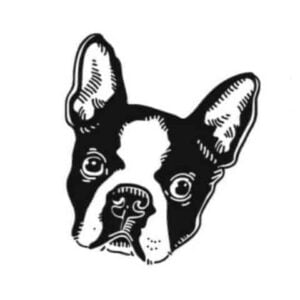Have you ever wondered which dog breeds have the longest and shortest lifespans?
We’ve created this fun, comprehensive dog breed lifespan chart listing all these amazing pups from shortest to longest life expectancy. Regardless of whether you choose a puppy with a shorter lifespan, there are ways to maximize the time you have together and create cherished memories and adventures with your loyal companion.

Let’s get started!
What You Need To Know About Dog Breed Life Expectancy
Dog Breed Lifespan Chart
As dog lovers, we want the best for a furry friend but unfortunately, all good things do end. Just know that the dog life expectancy chart below is simply average lifespans for most dogs. While we would love to have our pet dog live forever, this sadly is not the case. Some simple things to keep in mind our:
- Enhance the likelihood of a prolonged life by selecting a puppy from a reputable breeder who prioritizes the well-being of their pups.
- Small breed dogs typically live longer than medium breed breeds. And medium breeds typically live longer than larger breeds.
- Your dog’s health can play a role in increasing dog longevity. Simply start by ensuring your dog maintains a healthy weight.
| Breed | Lifespan | General Weight |
| Dogues de Bordeaux | 5 – 8 years | 110 lbs & up |
| Irish Wolfhounds | 6 – 8 years | 120 lbs |
| Mastiffs | 6 – 10 years | 160-230 lbs |
| Leonbergers | 7 years | 110-170 lbs |
| Neapolitan Mastiffs | 7 – 9 years | 150 lbs |
| Bullmastiffs | 7 – 9 years | 110-130 lbs |
| Bernese Mountain Dogs | 7 – 10 years | 80-115 lbs |
| German Shepherd Dogs | 7 – 10 years | 65-90 lbs |
| Great Danes | 7 – 10 years | 140-175 lbs |
| Bulldogs | 8 – 10 years | 50 lbs |
| Retrievers (Flat-Coated) | 8 – 10 years | 60-70 lbs |
| St. Bernards | 8 – 10 years | 140-180 lbs |
| Greater Swiss Mountain Dogs | 8 – 11 years | 115-140 lbs |
| Scottish Deerhounds | 8 – 11 years | 85-110 lbs |
| Chinese Shar-Pei | 8 – 12 years | 45-60 lbs |
| Chow Chows | 8 – 12 years | 45-70 lbs |
| Newfoundlands | 9 – 10 years | 130-150 lbs |
| Rottweilers | 9 – 10 years | 95-135 lbs |
| Boerboels | 9 – 11 years | 150-200 lbs |
| Cane Corso | 9 – 12 years | Proportionate to height (100+ lbs) |
| Borzois | 9 – 14 years | 75-105 lbs |
| Old English Sheepdogs | 10 – 12 years | 60-100 lbs |
| Beaucerons | 10 – 12 years | 70-110 lbs |
| Black and Tan Coonhounds | 10 – 12 years | 65-110 lbs |
| Black Russian Terriers | 10 – 12 years | 80-130 lbs |
| Bloodhounds | 10 – 12 years | 90-110 lbs |
| Bouviers des Flandres | 10 – 12 years | 70-110 lbs |
| Boxers | 10 – 12 years | 65-80 lbs |
| Doberman Pinschers | 10 – 12 years | 75-100 lbs |
| English Toy Spaniels | 10 – 12 years | 8-14 lbs |
| French Bulldogs | 10 – 12 years | under 28 lbs |
| Great Pyrenees | 10 – 12 years | 100 lbs & up |
| Japanese Chin | 10 – 12 years | 7-11 lbs |
| Komondorok | 10 – 12 years | 100 lbs or more |
| Kuvaszok | 10 – 12 years | 100-115 lbs |
| Retrievers (Curly-Coated) | 10 – 12 years | 60-95 lbs |
| Rhodesian Ridgebacks | 10 – 12 years | 85 lbs |
| Tibetan Mastiffs | 10 – 12 years | 90-150 lbs |
| Pointers (German Shorthaired) | 10 – 12 years | 55-70 lbs |
| Retrievers (Golden) | 10 – 12 years | 65-75 lbs |
| Spaniels (Clumber) | 10 – 12 years | 70-85 lbs |
| Spinoni Italiani | 10 – 12 years | 56 lbs |
| Retrievers (Chesapeake Bay) | 10 – 13 years | 65-80 lbs |
| Weimaraners | 10 – 13 years | 70-90 lbs |
| English Foxhounds | 10 – 13 years | 60-75 lbs |
| Greyhounds | 10 – 13 years | 65-70 lbs |
| Otterhounds | 10 – 13 years | 115 lbs |
| Akitas | 10 – 14 years | 100-130 lbs |
| Alaskan Malamutes | 10 – 14 years | 85 lbs |
| Spaniels (American Water) | 10 -14 years | 30-45 lbs |
| Spaniels (Boykin) | 10 – 15 years | 30-40 lbs |
| Beagles (13 inches & under) | 10 – 15 years | under 20 lbs |
| Beagles (13-15 inches) | 10 – 15 years | 20-30 lbs |
| Glen of Imaal Terriers | 10 – 15 years | 32-40 lbs |
| Puli | 10 – 15 years | 25-35 lbs |
| Sloughis | 10 – 15 years | 35-50 lbs |
| Salukis | 10 – 17 years | 40-65 lbs |
| Poodles (miniature) | 10 – 18 years | 10-15 lbs |
| Poodles (standard) | 10 – 18 years | 60-70 lbs |
| Poodles (toy) | 10 – 18 years | 4-6 lbs |
| Shih Tzu | 10 – 18 years | 9-16 lbs |
| American English Coonhounds | 11 – 12 years | 45-65 lbs |
| Bluetick Coonhounds | 11 – 12 years | 55-80 lbs |
| American Foxhounds | 11 – 13 years | 65-70 lbs |
| Anatolian Shepherd Dogs | 11 – 13 years | 110-150 lbs |
| Dalmatians | 11 – 13 years | 45-70 lbs |
| Entlebucher Mountain Dogs | 11 – 13 years | 55-65 lbs |
| Miniature Bull Terriers | 11 – 13 years | 18-28 lbs |
| Portuguese Water Dogs | 11 – 13 years | 42-60 lbs |
| Retrievers (Labrador) | 11 – 13 years | 65-80 lbs |
| Airedale Terriers | 11 – 14 years | 50-70 lbs |
| Ibizan Hounds | 11 – 14 years | 50 lbs |
| Australian Terriers | 11 – 15 years | 12-18 lbs |
| Setters (Irish Red and White) | 11 – 15 years | 42-60 lbs |
| Yorkshire Terriers | 11 – 15 years | 7 lbs |
| Bedlington Terriers | 11 – 16 years | 17-23 lbs |
| Briards | 12 years | 55-100 lbs |
| Scottish Terriers | 12 years | 19-22 lbs |
| Setters (English) | 12 years | 65-80 lbs |
| Basset Hounds | 12 – 13 years | 40-65 lbs |
| Berger Picards | 12 – 13 years | 50-70 lbs |
| Bull Terriers | 12 – 13 years | 50-70 lbs |
| Miniature American Shepherds | 12 – 13 years | 20-40 lbs |
| Pembroke Welsh Corgis | 12 – 13 years | up to 30 lbs |
| Pumi | 12 – 13 years | 27-29 lbs |
| Setters (Gordon) | 12 – 13 years | 55-80 lbs |
| Spaniels (Field) | 12 – 13 years | 35-50 lbs |
| Spaniels (Irish Water) | 12 – 13 years | 55-68 lbs |
| Treeing Walker Coonhounds | 12 – 13 years | 50-70 lbs |
| Soft Coated Wheaten Terriers | 12 -14 years | 35-40 lbs |
| Spanish Water Dogs | 12 -14 years | 40-49 lbs |
| Vizslas | 12 -14 years | 55-60 lbs |
| Wirehaired Vizslas | 12 -14 years | 55-65 lbs |
| Bearded Collies | 12 – 14 years | 45-55 lbs |
| Belgian Sheepdogs | 12 – 14 years | 55-75 lbs |
| Belgian Tervuren | 12 – 14 years | 55-75 lbs |
| Bolognese | 12 – 14 years | 6-10 lbs |
| Brittanys | 12 – 14 years | 30-40 lbs |
| Cirnechi dell’Etna | 12 – 14 years | 22-26 lbs |
| Collies | 12 – 14 years | 60-75 lbs |
| German Pinschers | 12 – 14 years | 25-45 lbs |
| Icelandic Sheepdogs | 12 – 14 years | 30 lbs |
| Pekingese | 12 – 14 years | up to 14 lbs |
| Peruvian Inca Orchid | 12 – 14 years | 8.5-17.5 lbs |
| Pharaoh Hounds | 12 – 14 years | 45-55 lbs |
| Plotts | 12 – 14 years | 50-60 lbs |
| Polish Lowland Sheepdogs | 12 – 14 years | 30-50 lbs |
| Retrievers (Nova Scotia Duck Tolling) | 12 – 14 years | 35-50 lbs |
| Russell Terriers | 12 – 14 years | 9-15 lbs |
| Samoyeds | 12 – 14 years | 45-65 lbs |
| Sealyham Terriers | 12 – 14 years | 23-24 lbs |
| Shetland Sheepdogs | 12 – 14 years | 15-25 lbs |
| Siberian Huskies | 12 – 14 years | 45-60 lbs |
| Skye Terriers | 12 – 14 years | 35-45 lbs |
| Spaniels (English Cocker) | 12 – 14 years | 28-34 lbs |
| Spaniels (English Springer) | 12 – 14 years | 50 lbs |
| Staffordshire Bull Terriers | 12 – 14 years | 28-38 lbs |
| Norwegian Buhunds | 12 – 15 years | 31-40 lbs |
| Norwegian Elkhounds | 12 – 15 years | 55 lbs |
| Norwegian Lundehunds | 12 – 15 years | 20-30 lbs |
| Norwich Terriers | 12 – 15 years | 12 lbs |
| Affenpinschers | 12 – 15 years | 7-10 lbs |
| Australian Shepherds | 12 – 15 years | 50-65 lbs |
| Border Collies | 12 – 15 years | 30-55 lbs |
| Border Terriers | 12 – 15 years | 13-15.5 lbs |
| Brussels Griffons | 12 – 15 years | 8-10 lbs |
| Canaan Dogs | 12 – 15 years | 45-55 lbs |
| Cardigan Welsh Corgis | 12 – 15 years | 30-38 lbs |
| Cavalier King Charles Spaniels | 12 – 15 years | 13-18 lbs |
| Cesky Terriers | 12 – 15 years | 14-24 lbs |
| Chinooks | 12 – 15 years | 55-90 lbs |
| Dandie Dinmont Terriers | 12 – 15 years | 18-24 lbs |
| Finnish Lapphunds | 12 – 15 years | 33-53 lbs |
| Fox Terriers (Smooth) | 12 – 15 years | 18 lbs |
| Fox Terriers (Wire) | 12 – 15 years | 18 lbs |
| Giant Schnauzers | 12 – 15 years | 60-85 lbs |
| Harriers | 12 – 15 years | 45-60 lbs |
| Keeshonden | 12 – 15 years | 35-45 lbs |
| Kerry Blue Terriers | 12 – 15 years | 33-40 lbs |
| Lakeland Terriers | 12 – 15 years | 17 lbs |
| Lhasa Apsos | 12 – 15 years | 12-18 lbs |
| Maltese | 12 – 15 years | 7 lbs |
| Miniature Schnauzers | 12 – 15 years | 11-20 lbs |
| Portuguese Podengo Pequenos | 12 – 15 years | 9-13 lbs |
| Redbone Coonhounds | 12 – 15 years | 45-70 lbs |
| Setters (Irish) | 12 – 15 years | 70 lbs |
| Swedish Vallhunds | 12 – 15 years | 20-35 lbs |
| Spaniels (Welsh Springer) | 12 -15 years | 40-55 lbs |
| Tibetan Spaniel | 12 -15 years | 9-15 lbs |
| Welsh Terriers | 12 -15 years | 20 lbs |
| Whippets | 12 -15 years | 25-40 lbs |
| Wirehaired Pointing Griffons | 12 -15 years | 50-70 lbs |
| Norfolk Terriers | 12 – 16 years | 11-12 lbs |
| American Staffordshire Terriers | 12 – 16 years | 55-70 lbs |
| Australian Cattle Dogs | 12 – 16 years | 35-50 lbs |
| Dachshunds (miniature) | 12 – 16 years | 11 lbs & under |
| Dachshunds (standard) | 12 – 16 years | 16-32 lbs |
| Miniature Pinschers | 12 – 16 years | 8-10 lbs |
| Pomeranians | 12 – 16 years | 3-7 lbs |
| Schipperkes | 12 – 16 years | 10-16 lbs |
| Pointers | 12 – 17 years | 55-75 lbs |
| Afghan Hounds | 12 – 18 years | 50-60 lbs |
| Rat Terriers | 12 – 18 years | 10-25 lbs |
| Basenjis | 13 – 14 years | 24 lbs |
| American Eskimo Dogs (miniature) | 13 – 15 years | 10-20 lbs |
| American Eskimo Dogs (standard) | 13 – 15 years | 25-35 lbs |
| American Eskimo Dogs (toy) | 13 – 15 years | 6-10 lbs |
| Bergamasco | 13 – 15 years | 70-84 lbs |
| Boston Terriers | 13 – 15 years | 12-25 lbs |
| Cairn Terriers | 13 – 15 years | 14 lbs |
| Finnish Spitz | 13 – 15 years | 25-33 lbs |
| Irish Terriers | 13 – 15 years | 27 lbs |
| Lowchen | 13 – 15 years | 15 lbs |
| Parson Russell Terriers | 13 – 15 years | 13-17 lbs |
| Pugs | 13 – 15 years | 14-18 lbs |
| Silky Terriers | 13 – 15 years | 10 lbs |
| Toy Fox Terriers | 13 – 15 years | 3.5-7 lbs |
| Spaniels (Sussex) | 13 -15 years | 35-45 lbs |
| West Highland White Terriers | 13 -15 years | 15-20 lbs |
| Shiba Inu | 13 -16 years | 23 lbs |
| Standard Schnauzers | 13 – 16 years | 35-50 lbs |
| Chinese Crested | 13 – 18 years | 8-12 lbs |
| Xoloitzcuintli (miniature) | 13 – 18 years | 15-30 lbs |
| Xoloitzcuintli (standard) | 13 – 18 years | 30-55 lbs |
| Xoloitzcuintli (toy) | 13 – 18 years | 10-15 lbs |
| Bichons Frises | 14 – 15 years | 12-18 lbs |
| Italian Greyhounds | 14 – 15 years | 7-14 lbs |
| American Hairless Terriers | 14 – 16 years | 12-16 lbs |
| Belgian Malinois | 14 – 16 years | 60-80 lbs |
| Chihuahuas | 14 – 16 years | 6 lbs |
| Havanese | 14 – 16 years | 7-13 lbs |
| Papillons | 14 – 16 years | 5-10 lbs |
| Petits Bassets Griffons Vendeens | 14 – 16 years | 25-40 lbs |
| Pointers (German Wirehaired) | 14 – 16 years | 50-70 lbs |
| Russian Tsvetnaya Bolonka | 14 – 20 years | 6-9 lbs |
| Tibetan Terriers | 15 – 16 years | 18-30 lbs |
| Manchester Terriers | 15 – 17 years | under 12 lbs |
| Manchester Terriers Toy | 15 – 17 years | 12-22 lbs |
| Lagotti Romagnoli | 15 – 17 years | 28.5-35 lbs |
| Coton de Tulear | 15 – 19 years | 9-15 lbs |
| Pyrenean Shepherds | 17 – 19 years | 15-30 lbs |
When selecting a puppy to adopt, the breed’s life expectancy is worth considering. Our comprehensive lifespan chart provides an easy-to-follow guide, showcasing each breed’s typical life expectancy range and weight. For further details about a specific breed, click on the dog’s name.
Are you wondering which dog breeds are the most energetic? Check out this article – 201 Dog Breeds Ranked By Energy Level – Find Your Perfect Pup!

Find All Your Dog Lifespan Questions Answered Below
How long is a dog year?
Traditionally, one human year is considered equivalent to seven dog years, although this calculation is not exact. “Dog years” is a simplified way to understand a dog’s aging process. This method of calculation varies slightly depending on the size and breed of the dog.
Dogs mature quicker than humans early in their lives, so the first year of a dog’s life is roughly equivalent to 15 human years. The second year equals about nine human years. After that, each additional dog year equates to roughly five human years.
Check out this dog years chart converting dog years into human years:
The following information is based on findings from the American Veterinary Medical Association and is based on dogs weighing between 21 and 50 pounds. Smaller dogs tend to age slower than larger dogs.
| Human Years | Dog Years |
| 1 | 15 |
| 2 | 24 |
| 3 | 28 |
| 4 | 32 |
| 5 | 36 |
| 6 | 42 |
| 7 | 47 |
| 8 | 51 |
| 9 | 56 |
| 10 | 60 |
| 11 | 65 |
| 12 | 69 |
| 13 | 74 |
| 14 | 78 |
| 15 | 83 |
| 16 | 87 |
What is the average life expectancy of a dog?
The average life expectancy for any dog is 12.72 years, based on the data in the chart above. In comparison, the median age of a dog is 12 years. However, your dog’s life expectancy depends on many factors, such as breed type, genetics, overall pet health, nutrition, and more.
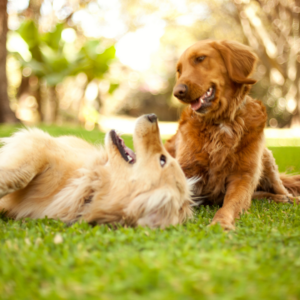
Do neutered and spayed dogs live longer than non-neutered and spayed dogs?
Yes, neutered male dogs have a longer lifespan of 18%, while spayed females enjoy an extended life of 23% compared to their non-neutered and spayed counterparts. This information came from the Banfield Pet Hospital’s State of Pet Health 2013 Report—where medical data from 2.2 million dogs were analyzed.
Do small dogs live longer than larger dog breeds?
Yes, smaller dog breeds tend to live 41% longer than larger breeds (source). Plus, if you simply look at the chart above, the top 25 dog breeds that have the shortest lifespan are dog breeds that have a typical weight of around 100 pounds. And if you go to the bottom of the chart to see dogs with the longest lifespan they are all smaller dogs weighing typically 30 pounds or less.
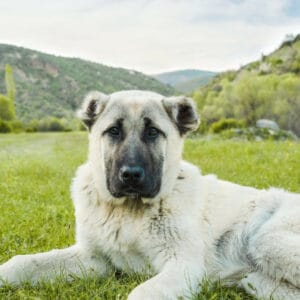
What Large Dog Breed Has The Longest Lifespan?
The Anatolian Shepherd Dog, renowned for its impressive stature, holds the distinction of being the largest dog breed with a remarkable life expectancy. With an average weight ranging from 110 to 150 lbs and a lifespan of 11 to 13 years, it stands alone as the only breed surpassing 100 lbs while possessing such remarkable longevity.
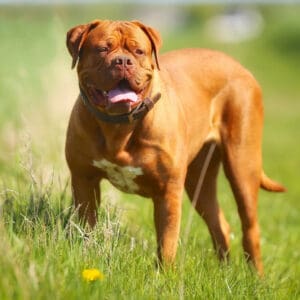
What dog breed has the shortest life expectancy?
The Dogues de Bordeaux breed has the shortest lifespan among dog breeds, only 5 to 8 years. However, they are cherished for their loyalty and protective nature, making them excellent family pets and guardians. Check out more info about this beloved breed in the chart below.
Top 10 Dog Breeds With The Shortest Life Expectancy
Here is a list of the top 10 dog breed lifespans in the American Kennel Club with the shortest life expectancy.
- Dogues de Bordeaux – 5 – 8 years
- Irish Wolfhounds – 6 – 8 years
- Mastiffs – 6 – 10 years
- Leonbergers – 7 years
- Neapolitan Mastiffs – 7 – 9 years
- Bullmastiffs – 7 – 9 years
- Bernese Mountain Dogs – 7 – 10 years
- German Shepherd Dogs – 7 – 10 years
- Great Danes – 7 – 10 years
- Bulldogs – 8 – 10 years

What dog breed has the longest life expectancy?
Within the American Kennel Club, Pyrenean Shepherds boast the longest life expectancy, ranging from 17 to 19 years. The Russian Tsvetnaya Bolonka is the only other breed surpassing 19 years, with a lifespan spanning from 14 to 20 years.
| Pyrenean Shepherd Traits & Characteristics | |
| Height | 15.5 – 18.5 inches (male rough-faced) 15 – 18 inches (female rough-faced) 15.5 – 21 inches (male smooth-faced) 15.5 – 20.5 inches (female smooth-faced) |
| Weight | 15 – 30 pounds |
| Affectionate With Family | 5 out of 5 |
| Good With Children | 3 out of 5 |
| Good With Other Dogs | 3 out of 5 |
| Shedding Level | 3 out of 5 |
| Coat Grooming Level | 2 out of 5 |
| Drooling Level | 2 out of 5 |
| Openess to Strangers | 3 out of 5 |
| Playfulness | 5 out of 5 |
| Watch Dog / Protective | 5 out of 5 |
| Adaptability (Routines vs non) | 4 out of 5 |
| Trainability | 5 out of 5 |
| Energy Level | 5 out of 5 |
| Barking Level | 4 out of 5 |
| Mental Stimulation Needs | 5 out of 5 |
| Average Lifespan | 17 – 19 years |
| American Kennel Club Group | Herding Group |
Top 10 Dog Breeds With The Longest Life Expectancy
Here is a list of the top ten dog breeds with the longest life expectancy in the American Kennel Club.
- Pyrenean Shepherds 17 – 19 years
- Coton de Tulear – 15 – 19 years
- Lagotti Romagnoli – 15 – 17 years
- Manchester Terriers & Manchester Terriers Toy – 15 – 17 years
- Tibetan Terriers – 15 – 16 years
- Russian Tsvetnaya Bolonka – 14 – 20 years
- Pointers (German Wirehaired) – 14 – 16 years
- Havanese – 14 – 16 years
- Chihuahuas – 14 – 16 years
- American Hairless Terriers – 14 – 16 years
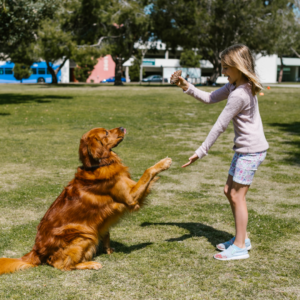
5 Dog Breeds With The Longest Lifespan And Are Great With Kids
Are you looking for a furry companion that will keep up with your wild kids and stick around for the long haul? Look no further than these loving dog breeds with some of the longest lifespans around. Plus, with an average lifespan of up to 14 years or more, you’ll be sure to have plenty of time to love and play with your new four-legged friend.
- Coton de Tulear – 15 – 19 years
- Russian Tsvetnaya Bolonka – 14 – 20 years
- Petits Bassets Griffons Vendeens – 14 – 16 years
- Papillons – 14 – 16 years
- Havanese – 14 – 16 years
How can I tell how long my dog will live?
Determining the exact lifespan of a dog can be challenging, as it depends on many factors including breed, size, genetics, diet, and lifestyle. However, some general indicators can offer an estimation.
- Firstly, consider the breed and size of your dog. Smaller dogs typically live longer than larger breeds, and purebred dogs often have more health issues that could affect their lifespan.
- Secondly, a dog’s diet and physical activity can significantly influence their life expectancy. A balanced diet, regular veterinary check-ups, and daily exercise can lead to a healthier life.
- Finally, the dog’s overall health status, including any chronic conditions or diseases, can directly affect their lifespan.
Remember, these are only estimates; individual dogs can undoubtedly live longer or shorter lives depending on unique circumstances.
What age is a dog considered senior?
In general, dogs transition into their senior years around the age of seven. The classification of a dog as a “senior” can vary based on breed and size. Larger breeds, like Great Danes or Newfoundland Dogs, may be considered seniors as early as five years old due to their shorter lifespan.
Conversely, smaller breeds like Chihuahuas or Yorkshire Terriers may not reach senior status until they’re ten years old. Monitor your pet’s health and behavior changes as they age, and consult with your vet for the best care during their golden years.
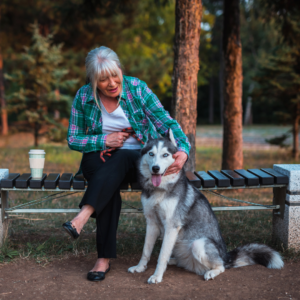
What percentage of dogs live past 15 years old?
18.4% of dogs have a life expectancy range that will have them living past 15 years of age. This is based on life expectancy data from two hundred and one American Kennel Club breeds. See the dog breed life expectancy table above for each dog’s lifespan.
Who was the longest-living dog?
The longest-living dog on record is Bobi age 31, a purebred Rafeiro do Alentejo Portuguese dog. Born on May 11, 1992, in Conqueiros, Leiria, Portugal, Bobi made history on February 2, 2023, as the first dog to reach the remarkable age of 30. See Bobi in the video below.
Watch this video produced by the Guinness Book Of World Records covering the life of Bobi, The Worlds Oldest Dog:
7 Tips For Helping Your Dog Live A Long Life
- Provide Proper Nutrition For A Lean Body: To keep your dog healthy and thriving, provide a balanced diet of high-quality proteins, carbs, and fats. But choose foods to create a lean body type.In a landmark study by Purina Scientists, Researchers tracked the health of 48 Labrador Retrievers from birth, with half of them being fed 25% less than their full-fed siblings. The findings revealed that dogs maintained in lean body conditions throughout their lives and enjoyed better and longer lives. See the following three points below.
- The median lifespan was extended by 1.8 years or 15%. The mean lifespan for lean-fed dogs was 13 years compared to 11.2 years for control-fed dogs.
- Additionally, the implementation of a 25% dietary restriction resulted in a delay of chronic disease symptoms in these canines.
- Implementing dietary restrictions did not have any negative impacts on skeletal maturation, structure, or metabolism.
- Exercise Regularly: Like humans, dogs need regular exercise to stay healthy and happy. Daily walks or backyard fetch games keep them fit and active. Teach them new tricks or take them to a park or beach for off-leash playtime to provide mental stimulation.
- Schedule Veterinary Checkups: Regular vet checkups are crucial for your pet’s health. Schedule at least one appointment per year (or more as advised by your vet) to catch any issues early and address them promptly.
- Keep Up With Vaccinations: Vaccinations are crucial for safeguarding your dog from deadly diseases like rabies, distemper, parvovirus, and more. Stay on top of their vaccinations as recommended by your veterinarian to ensure lifelong protection against these illnesses.
- Practice Good Dental Hygiene: Approximately 85% of dogs over four years of age have incurable periodontal disease (source). Maintaining your dog’s dental hygiene and avoiding poor dental health is crucial to overall longevity. Regularly brush their teeth with a dog-specific toothbrush and offer dental chews or treats to help remove plaque between brushings.
- Monitor Parasite Prevention: Parasites like fleas, ticks, heartworms, and various worms can harm dogs if untreated. Consult your vet about protecting your pet from these parasites for lifelong health.
- Provide Mental Stimulation: Mental stimulation is vital for your dog’s long-term health and happiness. Provide various activities like agility training, scent work, puzzle toys, interactive toys, and obedience classes to keep their minds sharp and engaged.

Final Thoughts
The life expectancy of your four-legged friend depends on many factors, from diet to preventative medical care, exercise, genetics, environmental factors, and more. Plus each breed has varied disadvantages or special needs that need to be considered when selecting the right pup for you and your family.
It’s important to remember that no matter what type of dog you have — big or small — it remains an incredible gift in your life!
Are you wondering which dog breeds are the most energetic? Check out this article – 201 Dog Breeds Ranked By Energy Level – Find Your Perfect Pup!
